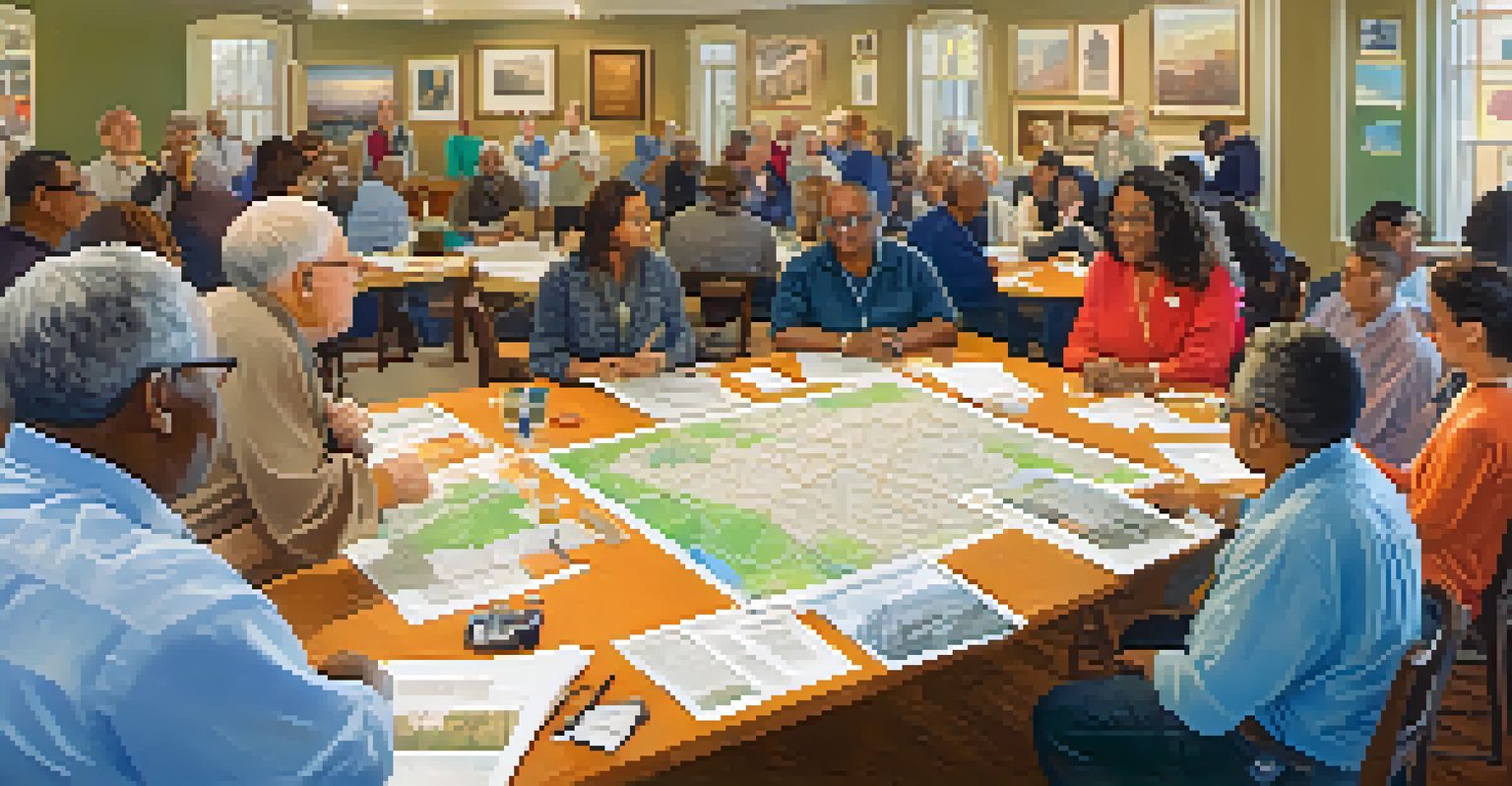The Role of Local Government in Sacramento's Preservation Efforts

Understanding Local Government's Role in Preservation
Local government plays a crucial role in preservation efforts by creating policies and programs that protect historical sites and cultural assets. In Sacramento, this responsibility is often undertaken by specific departments dedicated to heritage and environment. These entities work collaboratively with community organizations and residents to ensure that preservation is a shared goal.
Preservation is a form of stewardship that requires both community effort and government support.
One of the primary functions of local government is to establish regulations that guide development in historically significant areas. For instance, zoning laws can prevent inappropriate construction that may detract from the character of a neighborhood. By defining these regulations, local governments help maintain the unique charm that draws residents and tourists alike.
Additionally, local government facilitates funding and resources for preservation projects, making it easier for communities to engage in these efforts. Grants, tax incentives, and public funding can empower local organizations to take on restoration projects. This collaboration not only preserves history but also fosters a sense of community pride and identity.
Key Preservation Policies in Sacramento
Sacramento has implemented several key policies aimed at preserving its rich history. One notable example is the Sacramento Historic Preservation Program, which focuses on identifying and protecting significant landmarks. This program highlights the importance of both architectural and cultural heritage, ensuring that diverse narratives are included in the preservation dialogue.

Moreover, the city has adopted a comprehensive approach to preservation, integrating it into broader urban planning strategies. By aligning preservation with sustainability initiatives, local government can support environmentally friendly practices while honoring historical significance. This synergy not only enhances the aesthetic appeal of the city but also promotes long-term viability.
Local Government Drives Preservation
Local government in Sacramento creates policies and collaborates with communities to protect historical sites and cultural assets.
The local government also engages in regular assessments of historical sites, which helps update preservation strategies and policies as needed. By staying proactive, Sacramento ensures that its preservation efforts remain relevant and effective in a changing urban landscape, allowing future generations to appreciate the city’s rich heritage.
Community Involvement in Preservation Efforts
Community involvement is essential in shaping effective preservation strategies. Local government encourages residents to participate in discussions and decision-making processes regarding historical sites. This participatory approach cultivates a sense of ownership among community members, making preservation a collective effort rather than a top-down directive.
The past is not dead; it is not even past.
Public workshops, surveys, and forums provide platforms for residents to voice their opinions and share insights on what aspects of their heritage matter most. By listening to the community, local government can prioritize preservation efforts that reflect the values and history of Sacramento’s diverse population. This collaborative spirit enhances the legitimacy of preservation initiatives.
Furthermore, local nonprofits and advocacy groups often partner with the government to amplify community voices. These organizations can mobilize resources, raise awareness, and provide educational opportunities related to local history. Together, they create a powerful network that both supports and strengthens preservation efforts across the city.
The Impact of Historic Districts in Sacramento
Historic districts are a vital component of Sacramento's preservation landscape. These designated areas not only protect significant buildings and sites but also enhance the overall character of neighborhoods. By establishing historic districts, local government can guide development in a way that respects the history and culture of these areas.
In addition, historic districts often attract tourism and economic activity, benefiting local businesses. Visitors are drawn to the unique charm and stories of these neighborhoods, creating opportunities for shops, restaurants, and cultural events. This economic boost can be reinvested into further preservation efforts, creating a positive cycle of growth and sustainability.
Community Engagement is Key
Active participation from residents and local organizations enhances preservation efforts and fosters a sense of ownership in Sacramento.
Moreover, residents within historic districts often feel a heightened sense of community pride and connection to their surroundings. This emotional investment encourages them to participate actively in preservation initiatives, fostering a vibrant local culture that honors history while embracing the future.
Funding Sources for Preservation Projects
Funding is a critical aspect of successful preservation efforts in Sacramento. Local government allocates budgetary resources specifically for historical preservation projects, enabling various initiatives to come to life. Additionally, they often collaborate with state and federal programs that offer grants and financial incentives for preservation work.
Tax credits and grants are vital for both public and private entities looking to restore or maintain historic properties. For example, the Mills Act provides property tax relief for homeowners who agree to preserve their historic homes. This not only alleviates financial burdens but also motivates property owners to invest in their properties while contributing to the preservation of Sacramento's history.
Community fundraising events and partnerships with local businesses also play a role in securing funding for preservation projects. By uniting efforts and resources, the community can support local government initiatives, ensuring that Sacramento’s rich heritage is both preserved and celebrated for generations to come.
Challenges Faced by Local Government in Preservation
Despite the commitment to preservation, local government in Sacramento faces several challenges. Balancing development needs with preservation goals can often lead to conflicts, especially in a growing urban environment. As demand for housing and commercial spaces increases, the pressure to compromise on preservation standards can be significant.
Another challenge is securing consistent funding for preservation projects. Economic fluctuations can affect budget allocations, leading to uncertainty about the future of various initiatives. Without stable funding, ongoing maintenance and restoration efforts may falter, jeopardizing the preservation of valuable historical sites.
Funding Fuels Preservation Projects
Securing financial resources through grants, tax incentives, and community support is vital for the success of preservation initiatives in Sacramento.
Additionally, raising public awareness about the importance of preservation remains an ongoing effort. While many residents value their community’s history, others may not fully understand the significance of preserving it. Local government must continue to engage and educate the public about the benefits of preservation to cultivate a broader base of support.
Future Directions for Preservation in Sacramento
Looking ahead, the future of preservation efforts in Sacramento appears promising, yet it requires ongoing commitment and innovation. Local government is exploring new technologies and methodologies to enhance preservation practices. This includes utilizing digital tools for documenting and promoting historical sites, making them more accessible to the public.
Furthermore, as Sacramento continues to grow, integrating preservation into the city’s development plans will be crucial. This proactive approach can help ensure that new developments respect and enhance the historical context of existing neighborhoods. Engaging stakeholders early in the planning process will lead to more harmonious outcomes.

Lastly, fostering partnerships with educational institutions can play a vital role in future preservation efforts. By involving students and educators in projects, local government can inspire a new generation of preservationists who value and understand the importance of their community’s history. Together, these efforts can pave the way for a vibrant, historically rich Sacramento.